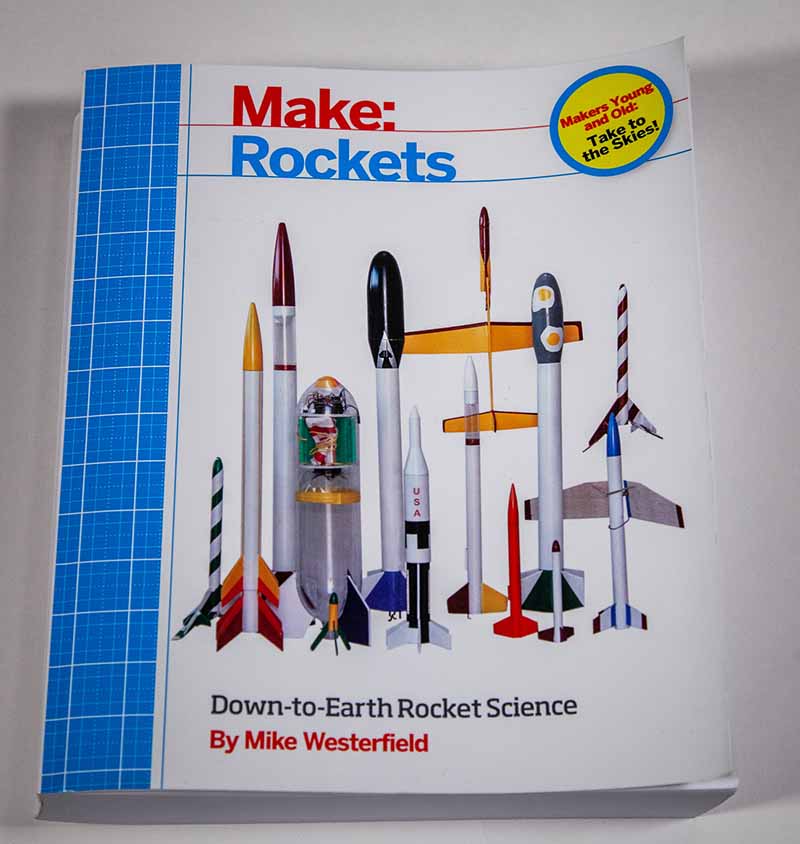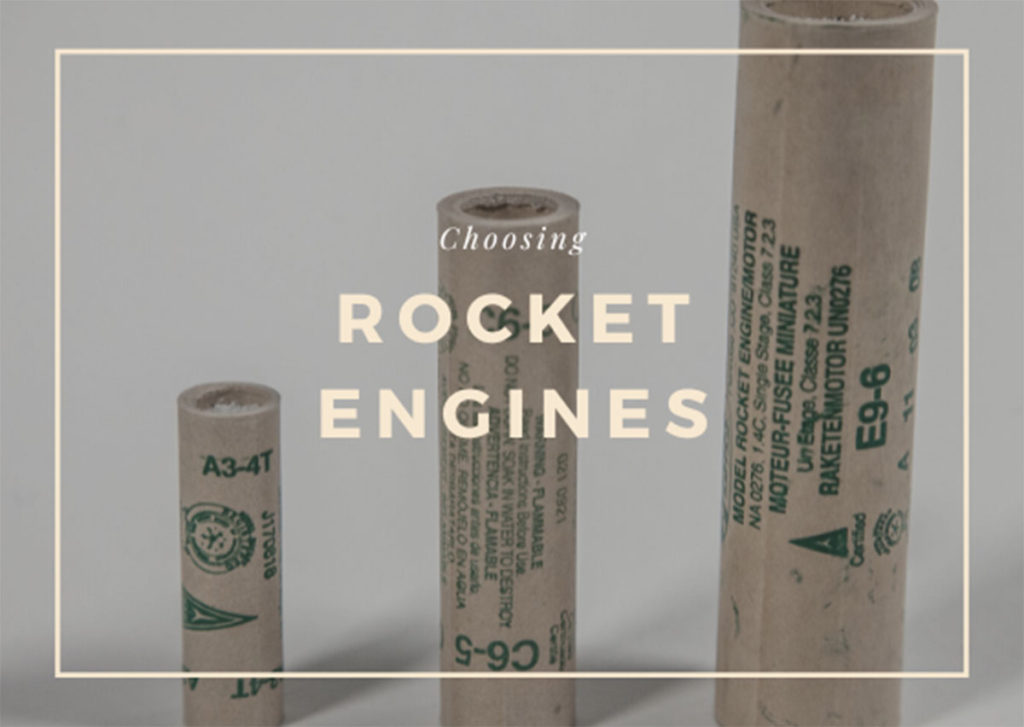
We may receive commissions from purchases made through links in this post, at no additional cost to you.
One of my favorite childhood memories was building and launching model rockets. There’s something so cool about the idea that I can take some basic materials (mostly paper-based), glue it together, stick a rocket engine in it, and watch it soar hundreds of feet in the air. What’s even cooler is knowing I can chase that rocket down, stick a new engine in it and do it again and again.
Fast forward a couple years (*ahem* decades… sigh), and I’ve decided it’s time to teach my kids how to launch model rockets. But with the greater availability of products on the internet, there are now so many more choices than just what’s at the local hobby shop.
This is especially true for choosing the right rocket engine. What once was a simple choice of the few rocket engines they had in stock at the hobby store (and a human being to help you choose), has now turned into so many possibilities. All those letters and numbers seem like gibberish and not in the least bit helpful.
The question arises, how do I choose the right engine for my rocket? The simplest answer is to follow the manufacturer’s recommendation which is often placed on the outside of the package.
New to rockets? Check out Model Rockets with Kids (What to Get and Where to Launch).

But even this example gives six options to choose from. Which engine should I choose? The short answer is to choose the least powerful motor, especially for your first flight. The key is to look at the letter. The lower the letter, the less powerful the engine. Therefore, an A engine will be a lower power engine than a B engine. (I’ll get more into specifics in a bit).
If you have ½ or ¼ before the letter A, that means it will be even less powerful than an A engine. 1/2A is generally half as powerful than A, and 1/4A is a quarter as powerful as A.
As tempting as it is to want to go as high as possible, start with a lower power engine for your first flight. If you want to go higher, go ahead and buy a packet of B and C engines too (the ones recommended by the manufacturer) and after you’ve done your first flight and know that your rocket flies nice and straight, then start going higher!
But what if they’re out of the recommended motors? Can you substitute with another kind of motor? The short answer is yes, but which motor you can choose to substitute with takes a little more explanation.
Related: Make My Rocket Fly Higher (Engine Selection and Finishing)
What Kind of Engines are Used in Model Rockets?
While there are a lot of rocket engine options (some single use, some reloadable), the typical beginner will launch a low-power rocket (more on this in a bit) using a single-use, black powder engine. All of those recommended Estes engines on the box are single-use, black powder engines. They’re easy to come by, relatively cheap, and easy to use.
If you decide to get more into the hobby, you’ll likely explore more advanced options of composite engines that can be reloadable. But that’s another article for another day. Today, we’re sticking with the basics and keeping it simple.
Are Model Rocket Engines Explosive?
Now hold on a second. It’s made of black powder. That sounds dangerous. Is it safe to store and use black powder engines?
In a word, yes! Like anything, there is a danger if anything is mishandled. The most common injury though, would be a burn, but that’s only from doing things the instructions on the engines and in your model rocket kit say to never do, like taking a motor apart or lighting it with a match.
Again, to hammer that point home, never take apart a rocket engine or light it with a match or fuse. In fact, don’t use it in any way except for its intended use as stated on the package. Do I need to say that again for the people in the back? Don’t be stupid about how you use an engine and you’ll be perfectly safe.
Your rocket engines come with solar ignitors, and you should always use an electric ignitor from a safe distance. The good news is that many beginner rocket kits now even come with a launch pad and an ignition system.
If you need help picking one out, check out Best Beginner Model Rockets to Build and Launch with Your Kids.
The truth is, on average, there are more deaths attributed to skateboarding then there are reported cases of burns from rocket engines. One study has found only 18 burns reported over an 18-year period. I think the odds are in your favor that you will be safe launching a rocket (especially when you follow the rules).
This article is originally from www.dadstuffsite.com
Model Rocket Engine Codes Explained
There are a number of model rocket companies that make rocket engines, but we’re going to stick with Estes engines because they are the most commonly available (you could order most of them on Amazon or find them at a lot of hobby and craft stores right now), and beginner-friendly on the market.

But when you first look at the numbers, they may seem like gibberish. Stick with me a little longer—I promise this will all make sense, and by the end of this, you’ll have no problems making any necessary substitutions.
Related: How High Did My Rocket Fly? (3 Ways to Measure Altitude)
What Does the First Letter Mean? Total Impulse Explained
Thrust is the propulsive force of the motor, or how much it pushes on the rocket and is measured in newton-seconds. The graph below shows the graph of an Estes A3 rocket engine. The graph shows the amount of thrust (measured in Newtons) over time (measured in seconds).
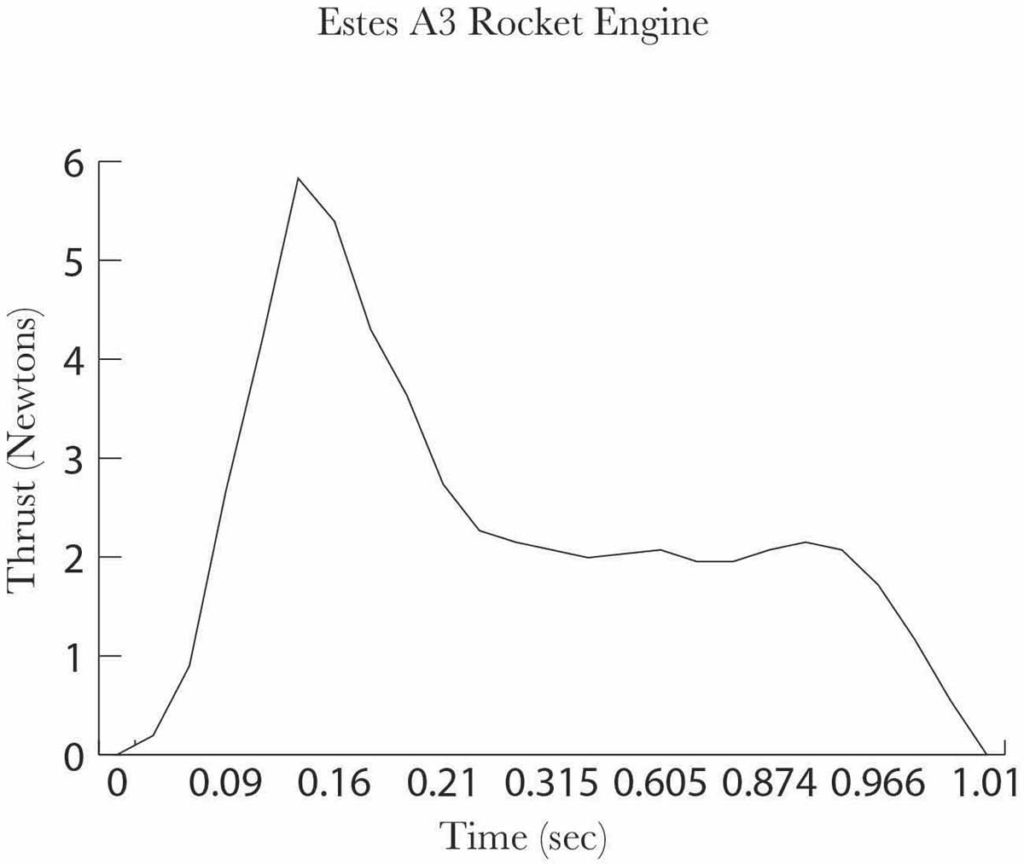
The Total Impulse is defined as the impulse for the entire time the engine provides thrust. The graph below is of the same Estes A3 rocket engine, but the shaded area of the graph represents the Total Impulse of the engine.
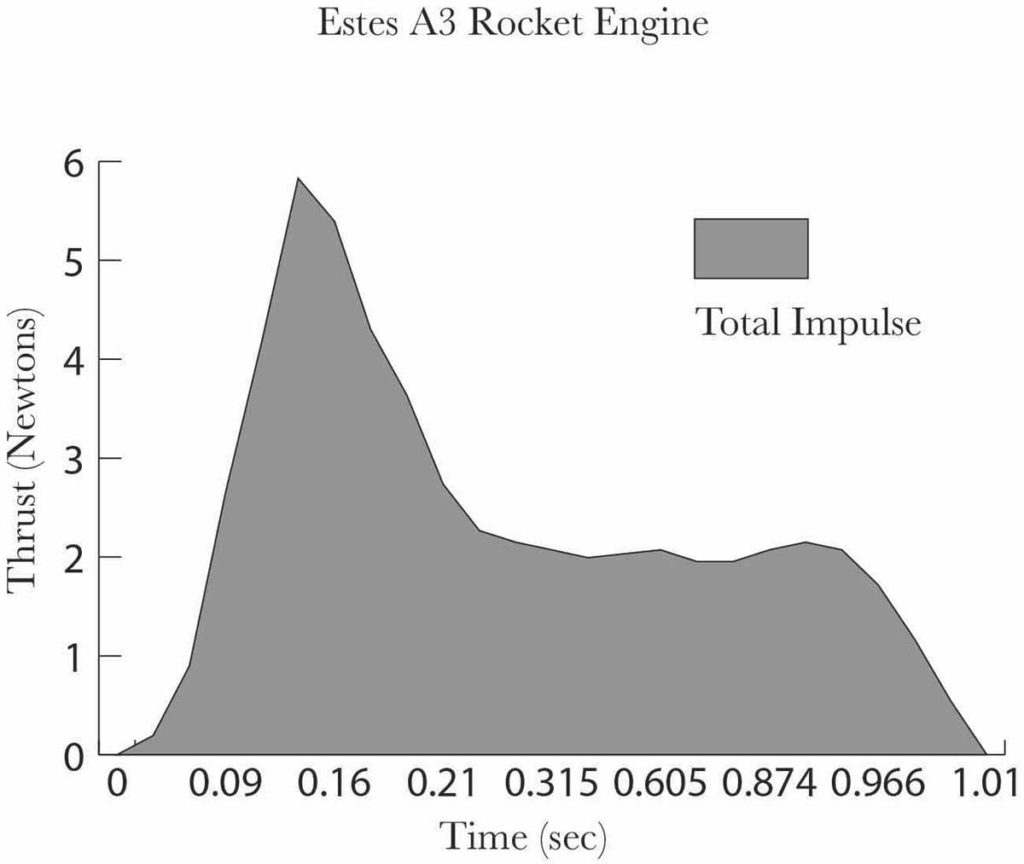
The first letter of a rocket engine code represents a defined range of the Total Impulse. Rocket engines are classified by their Total Impulse measured in Newton-seconds (N-s). While Newton-seconds are a more accurate measurement for power, in model rocketry a shorthand is used and letter is given to a range of power.
Below is a common chart for how hobby rocket motors are classified. On the left, you see the rocket engine class (the letter on a model rocket engine), the maximum total impulse in the middle, and the category of model rocketry.
| Class | Max Total Impulse (Newton seconds) | Type |
| 1/4A | 0.625 | Low Power |
| 1/2A | 1.25 | Low Power |
| A | 2.5 | Low Power |
| B | 5 | Low Power |
| C | 10 | Low Power |
| D | 20 | Low Power |
| E | 40 | Mid Power |
| F | 80 | Mid Power |
| G | 160 | Mid Power |
| H | 320 | High Power Level 1 |
| I | 640 | High Power Level 1 |
| J | 1,280 | High Power Level 2 |
| K | 2,560 | High Power Level 2 |
| L | 5,120 | High Power Level 2 |
| M | 10,240 | High Power Level 3 |
| N | 20,480 | High Power Level 3 |
| O | 40,960 | High Power Level 3 |
As I mentioned earlier, the letter is a shorthand that represents a range for Total Impulse. So our Estes A3 rocket engine has a total impulse that is in the range between 1.26 and 2.5 N-s.
Each successive letter has double the maximum Total Impulse of the previous letter. Therefore, a class B engine has a maximum Total Impulse double that of a class A engine, at a range between 2.5 and 5.0 N-s.
Generally, most black powder motors up until class E engines are going to be manufactured to the upper limits. Beyond that, the difference between each category is so large that it is common to find motors not at the upper limits of its classification.
Related: How Big (and Small) Can You Make A Model Rocket?
What Does the First Number Mean? Average Thrust Explained:
The first number that comes immediately after the letter represents the average thrust of the rocket engine. The Average Thrust is calculated by dividing the Total Impulse by the Burn Time.
This article is originally from www.dadstuffsite.com

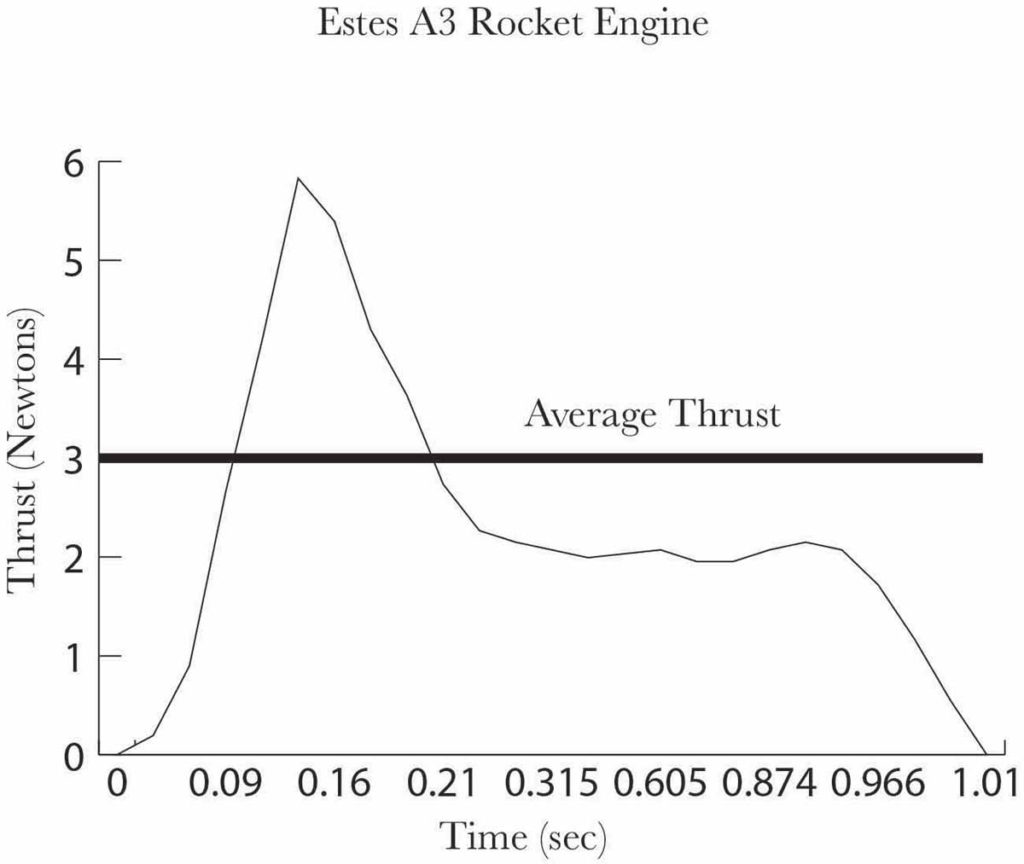
Average thrust is a measure of how quickly or slowly the motor provides thrust. The higher the number, the shorter the amount of time it takes to spend the total energy. As the number gets lower, the total energy is spent over a longer period of time.
As you can see in the graph below comparing Estes A3 and A10 engines. The same amount of energy is spent, but the amount of energy that is spent over time is different. The A10 engine uses more of the potential energy immediately and reaches burn out before the A3 engine. The A3 engine uses much less thrust at take-off, but it has a longer burn time.
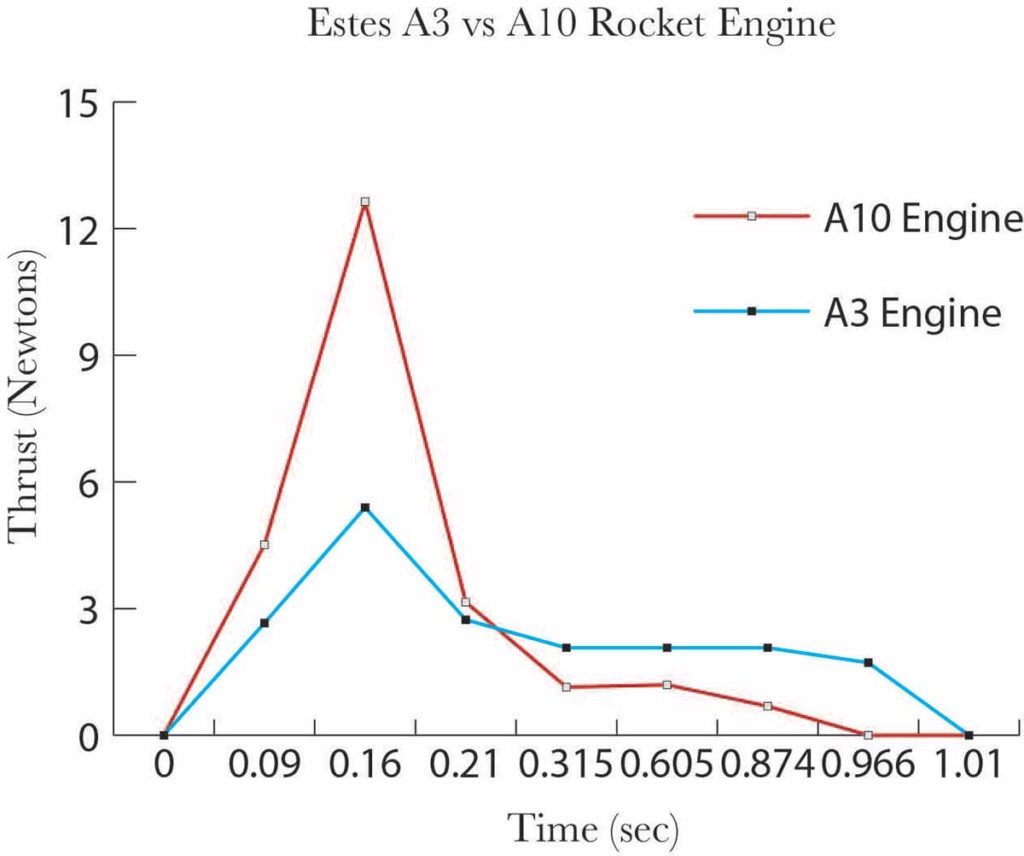
So generally, we can say that a rocket engine with a high number (the A10) would be for a heavier rocket that needs more thrust at take-off, and the lower number (the A3) would be a better option for a lighter rocket.
What Does the Second Number Mean? Time Delay Explained:
After the moment of burnout, a rocket engine will ignite an ejection charge. This small burst will push the nosecone off the top of the rocket and deploy either a parachute or streamer. Because the rocket is moving so quickly right after burnout, releasing the recovery system immediately will put too much pressure on the parachute or streamer and can cause the cord to break or separate from the rocket.
Therefore, it is best to release the recovery system as close to the moment of apogee (the highest point of flight before gravity brings your rocket back to earth) as possible. This is done by delaying the ejection charge in the engine. The second number printed on the rocket engine correlates to the seconds of delay before the ejection charge ignites.
The cutaway image of the Estes engine below shows the different layers inside a black powder rocket engine.
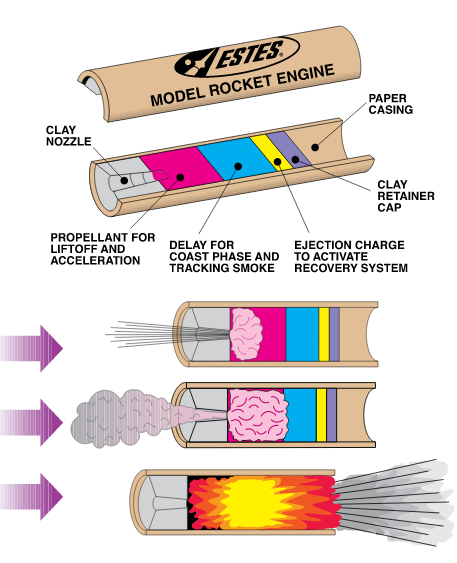
For more on recovery systems for model rockets, check out Parachutes vs. Streamers (Model Rocket Recovery Systems).
What Do the Different Colors on Estes Rockets Mean?
With all the different number combinations, it’s easy to see that some engines have a particular function. Estes has gone and color coded their engine codes to help simplify the process of choosing the right engine.
Some engines work best with regular single stage rockets. These types of engines have the engine codes printed in green.
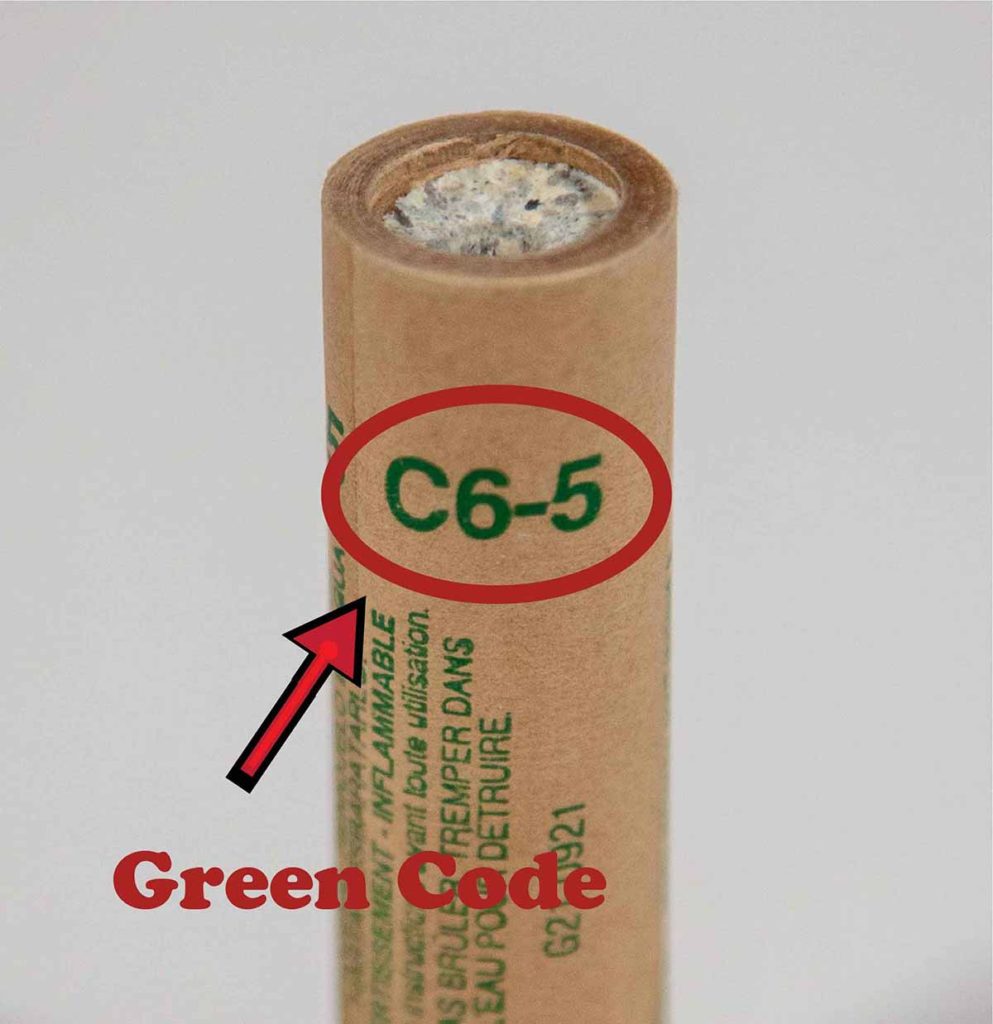
This article is originally from www.dadstuffsite.com
If you have a two-stage rocket, however, you don’t need an ejection charge. Instead, you need the first-stage engine (booster) to ignite the second stage. The booster engine will have the code printed in red and will have an ejection charge number of “0”.
The second-stage engine will be printed in purple and will typically have a higher ejection charge number than many single-stage (green) engines. This is because between the two engines (the booster and second-stage), the rocket will be going very fast at burn out and will take longer to get to apogee than an average single-stage rocket.
The last kind of engine is one that has no ejection charge and is plugged at the end. This is a specialty engine and the code is printed in blue. This is for rockets that are typically so small that they don’t have any recovery system.
Related: Recovery Wadding in Model Rockets (What it Is and 3 Types)
Are There Different Sizes for Model Rocket Engines?
Now that you understand the basics of Estes engine codes, there is another factor to keep in mind when choosing engines. Not all engines come in the same size, and while you’re not likely to mix most of them up, I will confess that I have bought the wrong size engines on Amazon before.
There are three basic sizes for low-powered rocketry measured by the engine’s diameter: 13mm (mini, also known as a “T” sized engine), 18mm (standard), and 24mm (large). If you’re following the manufacturer’s directions, you’ll be fine, but if you have to improvise, then it can be a little confusing to see A class engines in 13mm and 18mm sizes (*amen* my mistake) and class C engines in 18mm and 24 mm.
Here’s a little cheat-sheet for the three basic sizes and all the Estes rocket engines in each size:
- 13mm (mini): 1/4A3-3T, 1/2A3-2T, 1/2A3-4T, A3-4T, A10-0T, A10-3T
- 18mm (standard): 1/2A6-2, A8-3, A8-5, A8-0, B4-2, B4-4, B6-2, B6-4, B6-6, B6-0, C5-3, C6-3, C6-5, C6-7, C6-0
- 24mm (large): C11-0, C11-3, C11-5, C11-7, D12-0, D12-3, D12-5, D12-7, E12-0, E12-4, E12-6, E12-8
How to Pick the Right Size Engine
When it’s time to pick out the right engine for your rocket, always start with the manufacturer’s recommendations. However, if you find yourself stuck having to improvise, here are three(ish) rules to choosing a rocket engine:
1. Start by looking at engines of the same size diameter. You can’t put a bigger diameter engine in a rocket with a smaller diameter body. Simple laws of physics will prevent you from fitting an 18mm cylinder inside a 13mm cylinder.
2. Filter out any booster rockets. Unless you have a specialty rocket that needs a plugged engine, you can get rid of anything with a “0” for the last number and has the code printed in blue or red.
3a. Where you can fudge the manufacturer’s recommendation some is on the last number, the timing for the ejection charge. In a pinch, you can use a second stage motor (purple) with a longer ejection charge delay. Yes, I know that means it is likely to eject your parachute post apogee, but honestly, this isn’t a huge deal as your rocket hasn’t picked up too much momentum at this point.
3b. The other option you have, is to size up a class (not in size, but in class). I recommend sizing up over sizing down, because if Estes recommends a minimum class B engine, it’s because the rocket is heavier and needs some more oomph. Moving to a class C (that’s still 18mm) will give the minimum thrust that a class A probably won’t. This is an important consideration, because if it doesn’t get to a certain speed by the time it comes off the rod on your launch pad, that rocket may turn into a missile and not go straight up.
This article is originally from www.dadstuffsite.com
Diving Deeper into Model Rocketry
If you find yourself getting seriously into rocketry and you want to learn more, check out Make: Rockets by Mike Westerfield. Make is an awesome resource for so many things STEM-related and this book will give you everything you need to know about low-powered rocketry including compressed air and water rockets.
This book is no-joke and is about 1½ inches thick. This book has become my rocket bible and is a great resource (and no, Make did not ask me to say any of this).
Related Posts
Flying rockets is super fun. My kids and I have a blast launching them into the sky and chasing them down. We love the idea of putting in a stronger engine each time and seeing how high we can...
The weekend is coming up and the wife is out of town. That means I’m on full time Dad Duty. One of the things I learned when I have a long period of time with two kiddos and no back up from...

